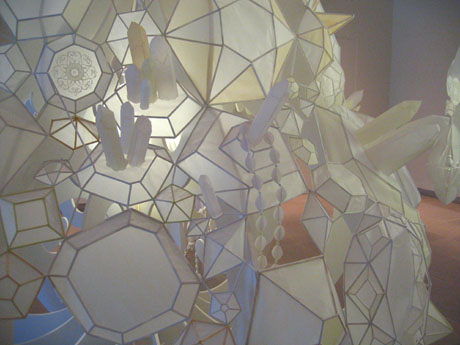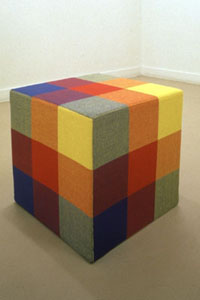I feel a little shy about liking this piece – it's so stereotypically feminine that I feel I need a woman to give me her perspective. I can imagine an unsophisticated woman loving this piece for its romanticism and beauty and a clever woman hating it for the same reasons. Me, I like it for its ambivalence. Sure, it's romantic and beautiful, airy and delicate, but it's also about being those things. Hassenfeld isn't just regurgitating bridal-shop motifs on a large scale, but neither is it a simplistic critique of those motifs. It's an exploration of what the kind of Nineteenth-century femininity symbolized by the bows and beads, swags and arabesques means to a mature woman in the twenty-first. Hasssenfeld can manipulate this imagery with assurance, because she owns it. Her genuine sentiment allows her to insert unexpected images like the broken tree branch with bracket fungi and the crawling crusts of crystals and not have them feel out of place.
Softly illuminated from within like hanging lamps, Hassenfeld's pieces are enormously elaborate paper lampshades. Floating weightlessly, each lamp slowly revolves in the currents of the gallery's air conditioning like belles in a ballroom. Dim light, dove-gray walls and floor tiles (this is the first show I've seen at Rice where those gray tiles seemed relevant) give the installation a lot of moonlit atmosphere. Each lamp hangs like a thought bubble, chained to a cameo portrait of a woman's head that I took for a portrait of the artist. Each bubble has layer upon layer of detail, from macroscopic curves to the most miniscule scrollwork; leading you to shift your focus ever inward; you to peer into the interiors of the lamps like a gypsy into a crystal ball to see an illuminated miniature dream world.
One lamp holds a figure in a bouffant hoopskirt. She twirls like music-box ballerina, swinging seven May baskets on seven arms. Across the gallery, a fairytale castle of crystals twined with ivy is centered in a hanging star. In each case, the fragility and translucency of the materials give them a faraway nostalgia that under most circumstances I'd find annoyingly precious, but in this case, I'm swallowing.
Maybe it's the undertone of decay that makes it palatable; networks of creeping crystals like jeweled kudzu are trying to strangle a couple of the shapes . Others are fettered with fallen paper chains. The bottom of the lowest bell is tinged with pink, as if it is bruised, or menstruating. Or maybe I'm just a sucker for artists who co-opt of familiar decorative genres, like Jim Iserman.
PS
Rainey: What’s the problem with romanticism and beauty??
Bill:
I don't know, but it sure makes a lot of people suspicious. I suppose it's because romanticism is conventionalized emotion, and usually lacks depth. It's also out of fashion nowadays. Since the Nineteenth century, when romanticism flourished, we as a culture have tended to prefer more realism in our art.
In Hassenfeld's case, there's also a very specific suspicion of kitsch, since most of the decorative elements she uses are found in the most saccharine and superficial decorative programs. It's on purpose- Hassenfeld scours nineteenth century sources for this imagery, the same frippery that drove Adolph Loos to associate ornament and crime. She's challenging us to re-evaluate a whole universe of related imagery, from Miss Havisham's lace to Little Bo Peep to Cinderella to the current fairy craze.
To some extent, it's the old high-art, low-art game, but, as I said, Hassenfeld makes it her own. It becomes an exploration of identity rather than a boring art-historical point. There's obviously something there for a lot of people, and she's mining it the same way a myriad of male artists use stereotypical hunting imagery to explore masculinity.
Romanticism is escapist. Lord knows we all need escape, but the standards are lower; it's much easier to produce a viable dreamworld than to penetrate the curtain of familiarity to reveal the fantastic weird beauty of our real-world existence. That's why fantasy and sci-fi, romance novels and thrillers, much as I'm a fan, aren't high art. All they need to do is take you away; they don't need to show you anything new.
In serious art, a century and a half ago, that used to be enough. But even in the nineteenth century there were standards; people distinguished between good romance and poor, hackneyed potboilers. A good fantasy is consuming and powerful, seamless and detailed. It latches onto archetypal fears and desires, and since those feelings are always the same, a good fantasy is necessarily stereotypical. The story is always the same; it's the quality of the telling that counts. Even if Hassenfeld isn't showing us anything unfamiliar, she's putting old motifs and materials together with panache.
PPS
Now, Rainey, look what you've got me doing! Sci-fi isn't high art, indeed! This is why I hardly ever write antything theoretical- you can say almost any preposterous thing and have it sound true, until you examine it closely. Then you can say just the opposite. I guess the problem isn't romanticism and beauty, it's sentimentality and prettiness, which are nearly the same thing. Hassenfeld's piece is romantic, but not sentimental, and beautiful, skating on the edge of pretty, so for me it's OK.








1 comment
come bash our performance work tonight!
Julia’s Parents are Out of Town!
6 Performance Works
4411 Leeland
6-9pm